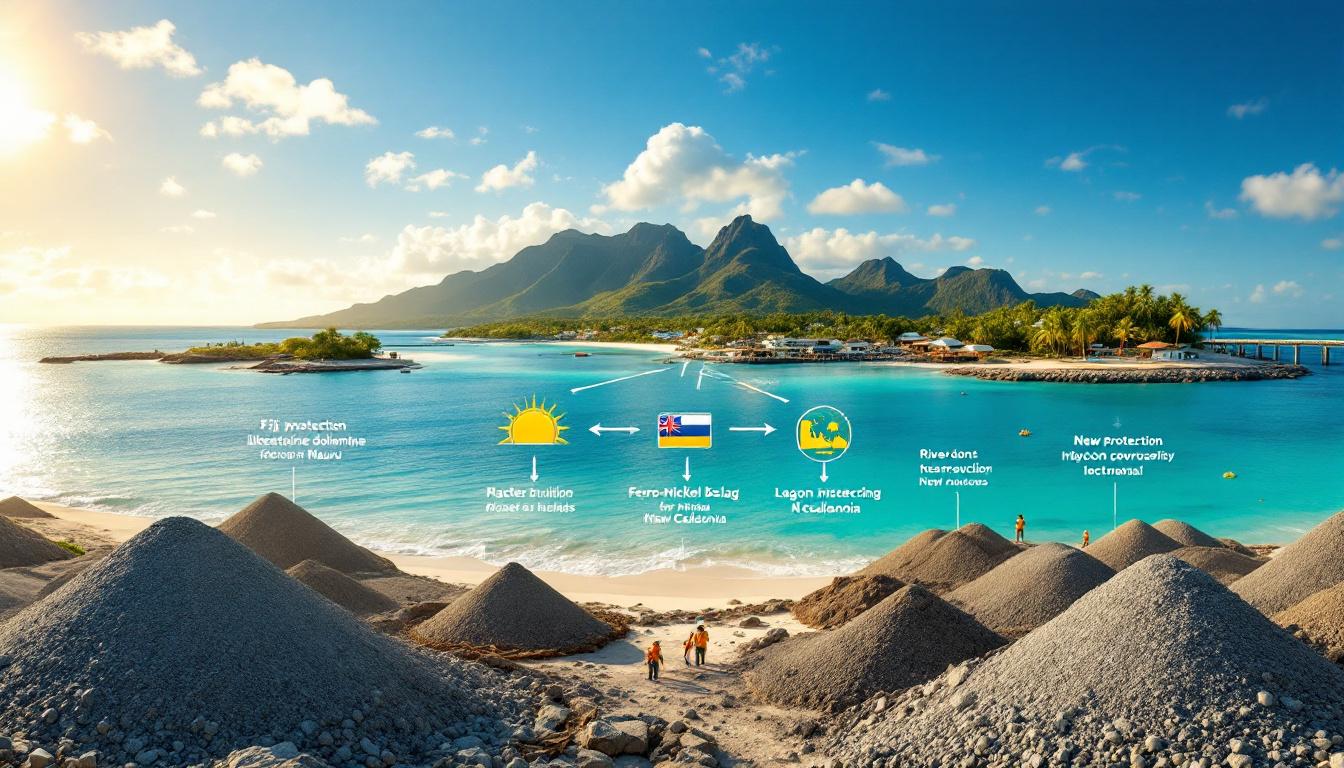Why Are Development Minerals Critical for Pacific Island Nations?
Pacific Island nations face unique challenges when it comes to infrastructure development. With limited local resources and growing construction needs, these countries require significant quantities of development minerals—materials like sand, gravel, and aggregate that form the literal foundation of infrastructure projects.
The Growing Demand for Construction Materials in the Pacific
The Asian Development Bank estimates that over $30 billion needs to be invested in Pacific infrastructure by 2030, creating an immense demand for construction materials. As climate change adaptation projects accelerate across the region, this demand continues to grow exponentially.
Development minerals are essential building blocks for constructing houses, roads, bridges, and coastal protection structures. These materials, while seemingly mundane, represent a critical resource for national development and climate resilience.
Dr. Paul Rogers, Senior Research Fellow at the Global Centre for Mineral Security, explains: "Mineral security has emerged as a pressing concern for the region: countries are forced to import, at high cost, large volumes of the materials necessary for their development, so alternatives are needed."
The Current Supply Challenge in the Pacific Region
The supply situation creates a significant economic challenge—up to 80% of the Pacific region's sand and aggregate currently comes from Fiji, creating a regional dependency on a single source nation.
"Many Pacific countries are built on rock made of calcite, a mineral unsuitable for many building applications," notes Dr. Rogers. This geological reality means that many islands cannot simply use local stone for construction purposes, as calcite-based materials lack the necessary structural properties and durability required for modern infrastructure.
The resulting high import costs create substantial economic burdens for developing island nations, diverting limited financial resources away from other critical development needs. For countries already facing economic challenges, these additional costs can delay or prevent essential infrastructure projects from moving forward.
Climate change adaptation projects further strain this supply chain, as coastal protection initiatives require enormous quantities of quality construction materials. As sea levels rise and extreme weather events become more frequent, the demand for sustainable mining practices will only increase.
How Are Fiji's Rivers Being Impacted by Mineral Extraction?
The heavy reliance on Fiji as the primary source of construction materials for the Pacific region has led to significant environmental consequences, particularly for Fiji's river systems.
Environmental Consequences of River-Based Extraction
Fiji's Navua River provides a sobering example of the environmental impacts of excessive extraction. Research indicates that the river has experienced alarming decreases in gravel bar area over recent decades due to over-extraction of river aggregates.
When extraction rates exceed the natural replenishment of sediments, river ecosystems suffer profound disturbances. The natural sediment transport processes that maintain healthy river systems become disrupted, leading to riverbank erosion, channel incision, and degraded aquatic habitats.
Robert Smith, a Fiji-based geophysicist who co-authored recent research on the topic, emphasizes: "We need to be looking for sustainable, alternative sources." This statement reflects the growing consensus among experts that current extraction rates from Fiji's rivers appear unsustainable without developing alternative material sources.
Excessive extraction disrupts the natural equilibrium of river systems in several ways:
- Reduced sediment load downstream, affecting natural beach nourishment
- Increased water velocity due to channel modifications, leading to erosion
- Degradation of aquatic habitats and spawning grounds
- Potential groundwater impacts through altered river-aquifer interactions
- Changes to river morphology that can increase flooding risks
The Ripple Effects on Local Communities
The environmental impacts of river degradation extend beyond ecological concerns, directly affecting communities dependent on these waterways. Local communities often rely on rivers for:
- Freshwater for drinking and agriculture
- Food sources through fishing
- Transportation routes
- Cultural and spiritual significance
- Natural flood mitigation
When river systems are compromised through excessive extraction, these community benefits diminish, creating social and economic hardships for riverine populations. The situation creates a complex sustainability challenge: balancing the urgent need for construction materials against the environmental and social costs of their extraction.
Local experts consistently emphasize the need for diversified supply sources to reduce pressure on Fiji's rivers. Finding this balance requires innovative approaches to identifying and developing alternative material sources that can meet regional construction needs while preserving critical ecosystems.
What Alternative Mineral Sources Exist in the Pacific?
Finding sustainable alternatives to river-extracted materials represents a critical opportunity for the Pacific region. Recent research has identified several promising options that could significantly reduce environmental pressures while meeting construction needs.
Repurposing Mining By-products as Construction Materials
One of the most promising approaches involves repurposing mining by-products that would otherwise remain as waste. These materials often possess physical and chemical properties suitable for construction applications:
Nauru's Limestone Dolomite Resource
Nauru possesses approximately 30 million cubic meters of limestone dolomite, a legacy from historical phosphate mining operations. This substantial resource can be crushed to produce high-quality aggregate suitable for concrete applications.
The material's properties make it particularly valuable for construction purposes:
- High compressive strength
- Good durability in marine environments
- Suitable particle size distribution after processing
- Chemical stability for long-term applications
New Caledonia's Ferro-nickel Slag
New Caledonia has an estimated 25 million tonnes of ferro-nickel slag available for repurposing. This material can serve multiple construction functions:
- Primary aggregate in concrete mixtures
- Supplementary cementitious material
- Road base material
- Controlled fill for land reclamation
Utilizing these mining by-products offers a dual benefit: providing needed construction materials while simultaneously reducing environmental liabilities associated with mine waste storage.
Innovative Approaches to Sustainable Extraction
Beyond repurposing existing materials, several innovative extraction approaches show promise for sustainable development:
Sustainable Lagoon Harvesting
"Even in the atoll countries such as Tuvalu, experience shows that sand aggregates can be harvested from lagoons at a sustainable rate, providing careful marine environment studies are undertaken," explains Robert Smith. This approach requires:
- Comprehensive baseline marine ecosystem assessments
- Careful extraction planning to maintain sediment balance
- Ongoing monitoring to prevent over-extraction
- Local capacity building for sustainable management
Ore-sand Production
Ore-sand by-products from silicate-rich metal ores represent a longer-term option for both domestic use and export. This innovative approach converts mining waste into valuable construction materials through specialized processing techniques.
Dr. Paul Rogers notes: "There is an amazing opportunity for Fiji and other Pacific Islands to reduce pressures on rivers, beaches and reefs by exploring alternative sources of aggregates." These alternatives could significantly reduce extraction pressures on vulnerable natural systems while providing economic opportunities through mine reclamation innovation.
How Can Pacific Nations Achieve Mineral Security?
Achieving mineral security requires coordinated regional approaches that leverage the diverse geological resources across Pacific nations. Through collaboration and sustainable management frameworks, countries can develop resilience in their construction material supply chains.
Regional Collaboration and Resource Sharing
Diversifying supply across multiple Pacific nations creates economic opportunities region-wide while reducing environmental pressures on any single source. Key strategies include:
Resource Mapping and Assessment
Comprehensive resource mapping insights help identify viable new sources of development minerals in the Pacific. This requires:
- Geological surveys of potential alternative sources
- Quality testing to determine suitability for various applications
- Environmental baseline studies to inform sustainable extraction plans
- Feasibility analyses for development and transportation
Transportation and Distribution Networks
Regional coordination can optimize transportation and distribution networks, reducing costs and environmental impacts:
- Development of maritime transport hubs
- Standardized handling facilities across ports
- Shared investment in specialized vessels for material transport
- Coordinated shipping schedules to maximize efficiency
Knowledge and Technology Sharing
Collaborative platforms for sharing best practices and technologies can accelerate adoption of sustainable approaches:
- Regional workshops and training programs
- Technology transfer agreements
- Shared research and development initiatives
- Coordinated testing and quality control standards
Sustainable Extraction Frameworks
Ensuring long-term viability requires robust frameworks for managing extraction activities:
Environmental Management Systems
Developing clear guidelines for sustainable extraction rates based on scientific principles helps prevent over-extraction. These should include:
- Science-based extraction limits
- Mandatory restoration requirements
- Buffer zones to protect sensitive habitats
- Seasonal restrictions when necessary to protect ecological functions
Monitoring and Enforcement
Implementing environmental monitoring systems with appropriate enforcement mechanisms ensures compliance with sustainability standards:
- Regular site inspections
- Remote sensing and automated monitoring technologies
- Community-based monitoring programs
- Transparent reporting requirements
- Graduated enforcement responses for non-compliance
Balancing Priorities
Finding the right balance between immediate construction needs and long-term environmental protection requires adaptive management approaches:
- Periodic reassessment of extraction limits based on monitoring data
- Integration with broader watershed and coastal management plans
- Alternative sourcing strategies during peak demand periods
- Life-cycle assessment of different material options
By developing these frameworks collaboratively, Pacific nations can achieve greater mineral security while protecting their natural environments for future generations.
What Economic Opportunities Could New Mineral Sources Create?
Developing alternative mineral sources creates significant economic opportunities beyond simply meeting construction needs. These new approaches can generate employment, reduce import costs, and create new export possibilities.
New Industry Development Potential
The development of processing facilities for alternative aggregates could create substantial local employment opportunities across the Pacific region. These facilities would generate jobs in several categories:
- Direct extraction and processing positions
- Equipment maintenance and technical services
- Quality control and laboratory testing
- Transportation and logistics
- Site rehabilitation and environmental management
For countries with surplus alternative materials, export opportunities could develop into significant revenue streams. Nauru's 30 million cubic meters of limestone dolomite and New Caledonia's 25 million tonnes of ferro-nickel slag represent valuable resources that could support regional construction needs while generating export income.
The economic benefits extend beyond direct employment and exports. Reduced import costs for construction materials would improve economic sustainability for development projects throughout the region, allowing limited financial resources to stretch further:
- Lower infrastructure development costs
- Improved feasibility for climate adaptation projects
- Reduced transportation carbon footprint
- Greater self-sufficiency and economic resilience
- Potential for value-added processing industries
Investment in Sustainable Mining Technologies
The transition to alternative construction materials creates opportunities for technology transfer and skills development. As Pacific nations develop expertise in sustainable extraction and processing, they can build valuable technical capacity:
- Specialized training programs for local workers
- Technical certification pathways
- Research partnerships with academic institutions
- Technology adaptation for local conditions
Potential partnerships with international mining and construction firms could accelerate technology transfer while providing access to global markets:
- Joint ventures for processing facilities
- Technical assistance agreements
- Equipment leasing and maintenance programs
- Export market development assistance
The development of specialized expertise in sustainable extraction methods represents a valuable economic asset that could be exported to other regions facing similar challenges:
- Consulting services
- Training programs
- Specialized equipment development
- Best practice guidelines and standards
By approaching alternative material development strategically, Pacific nations can transform a construction challenge into an economic opportunity with multiple benefits for local communities and create new investment opportunities 2025.
What Research Initiatives Are Supporting These Developments?
Research plays a critical role in identifying and developing alternative mineral sources. Several important initiatives are currently advancing knowledge in this area, providing the scientific foundation for sustainable approaches.
Comprehensive Resource Mapping
Recent collaborative research represents "the most comprehensive snapshot ever compiled of aggregates supply in the region," according to the University of Queensland. This detailed assessment provides an essential baseline for policy development and investment planning.
The research collaboration involves multiple organizations:
- University of Queensland researchers
- The Pacific Community
- Smith Geoscience Consulting
- Pacific Regional Infrastructure Facility
This multi-stakeholder approach ensures that the research addresses practical needs while maintaining scientific rigor. The resulting resource maps identify viable alternative sources with minimal environmental impact, providing decision-makers with actionable information.
Key elements of the resource mapping include:
- Geological assessment of potential sources
- Quality testing of alternative materials
- Environmental sensitivity analysis
- Extraction feasibility studies
- Transportation and logistics considerations
Partnerships Driving Innovation
Research partnerships are driving innovation in sustainable mineral sourcing. The collaboration between research institutions, regional organizations, and technical consultants creates a powerful knowledge ecosystem:
University of Queensland Researchers
Led by Dr. Paul Rogers, Senior Research Fellow at the Global Centre for Mineral Security, university researchers provide scientific expertise and methodological rigor. Their involvement ensures that developments are based on sound science and sustainable principles.
The Pacific Community
As the principal scientific and technical organization in the Pacific region, the Pacific Community provides crucial regional context and ensures research addresses local priorities and conditions.
Smith Geoscience Consulting
With Robert Smith, a Fiji-based geophysicist, serving as co-author of recent studies, this technical consulting firm bridges the gap between academic research and practical application in Pacific contexts.
Pacific Regional Infrastructure Facility
This partnership supports regional coordination efforts, helping to translate research findings into actionable policies and investment plans.
These research collaborations are establishing new paradigms for sustainable material sourcing in island contexts. By bringing together diverse expertise and stakeholder perspectives, they're developing approaches that balance development needs with environmental protection and contributing to evolving mining industry trends.
How Can Climate Resilience Be Enhanced Through Sustainable Mineral Sourcing?
Climate change poses existential threats to many Pacific Island nations. Sustainable mineral sourcing directly supports climate resilience by providing materials for adaptation infrastructure while preserving natural protective ecosystems.
Building Climate-Adaptive Infrastructure
Quality construction materials are essential for climate-resilient infrastructure that can withstand increasing storm intensity, sea level rise, and other climate impacts. These materials are needed for:
- Sea walls and coastal protection barriers
- Elevated roads and bridges
- Storm-resistant housing
- Water management systems
- Erosion control structures
Coastal protection projects require particularly significant quantities of appropriate aggregates. As Robert Smith notes, aggregate from Fiji rivers is currently supplying climate change adaptation projects across the Pacific region. However, sustainable alternatives are needed to meet growing demand without compromising river ecosystems.
The properties of construction materials directly influence infrastructure resilience:
- Durability in marine environments
- Resistance to erosion and weathering
- Structural integrity under extreme conditions
- Permeability characteristics for drainage
- Compatibility with local environments
Sustainable sourcing ensures long-term availability of materials for ongoing adaptation efforts. As climate impacts intensify, the ability to maintain and expand protective infrastructure will become increasingly vital for Pacific communities.
Reducing Environmental Vulnerability
Protecting river systems maintains natural flood protection that complements built infrastructure. Rivers with intact sediment transport processes provide:
- Natural flood buffering through floodplains
- Sediment deposition that maintains coastal beaches
- Groundwater recharge through riverbed infiltration
- Ecological corridors for species adaptation
- Temperature regulation through shading and water flow
Preserving coastal ecosystems supports natural barriers against storm surges, which are becoming more severe with climate change. When excessive extraction damages these ecosystems, communities lose valuable protection:
"Natural systems like mangroves, coral reefs, and beaches provide the first line of defense against storms and sea level rise. When we extract materials unsustainably, we weaken these natural protections at the very time we need them most."
Sustainable extraction maintains environmental services critical for climate resilience. By developing alternative material sources, Pacific nations can protect these natural defenses while still obtaining the materials needed for adaptation infrastructure.
The connection between sustainable mineral sourcing and climate resilience creates a powerful argument for developing alternative sources. Rather than seeing environmental protection and development as competing priorities, this approach recognizes their fundamental interdependence in building resilient Pacific communities.
FAQ: Development Minerals in the Pacific
What are development minerals?
Development minerals include construction materials like sand, gravel, aggregate, and other non-metallic minerals used primarily for domestic construction, manufacturing, and agriculture. Unlike metals or gemstones, these materials:
- Are typically low-value, high-volume resources
- Are used primarily for domestic development rather than export
- Form the literal foundation of infrastructure projects
- Are essential for climate adaptation structures
- Often receive less attention in mining policy and regulation
These materials may seem commonplace, but they represent critical inputs for national development that cannot be substituted or eliminated from construction processes.
Why can't Pacific Islands use local rock for construction?
Many Pacific Islands are formed from calcite-based rock, which lacks the necessary structural properties for many construction applications, particularly those requiring durability and strength. These limitations include:
- Insufficient compressive strength for structural concrete
- Poor durability in marine environments
- Vulnerability to chemical degradation
- Inadequate resistance to weathering
- Unsuitable particle characteristics for concrete mixes
Dr. Paul Rogers explains: "Many Pacific countries are built on rock made of calcite, a mineral unsuitable for many building applications." This geological reality creates the fundamental supply challenge that drives the need for imports or alternative sources.
How does mineral extraction impact river systems?
Excessive extraction disrupts natural sediment flow, causing multiple cascading impacts on river ecosystems:
- Riverbank erosion: When extraction exceeds natural replenishment rates, rivers often respond by eroding banks to reestablish sediment equilibrium
- Channel incision: Rivers may cut deeper channels, disconnecting from floodplains and lowering water tables
- Habitat destruction: Extraction directly removes aquatic habitats and spawning grounds
- Water quality degradation: Increased turbidity from extraction activities can harm aquatic species
- Altered flow dynamics: Changes to river morphology can increase flow velocities and flooding risks
- Reduced downstream sediment: Beaches and deltas may erode when sediment supply decreases
These impacts often extend well beyond the extraction site, affecting downstream communities and coastal environments that depend on natural sediment transport according to the
Ready to Identify the Next Major Mining Discovery?
Gain instant alerts on significant ASX mineral discoveries through Discovery Alert's proprietary Discovery IQ model, transforming complex data into actionable investment opportunities. Explore why major mineral discoveries can lead to exceptional returns by visiting Discovery Alert's dedicated discoveries page and start your 30-day free trial today.




